This is collection of reviews previously posted on Paul’s Thing: these are the books, old and new, that I most enjoyed reading this year. I’m about to embark on Philip Pullman’s “The Book of Dust,” a potential contender, but doubt I’ll finish it before the end of the year (also, I’m sometimes disappointed with long-delayed comebacks from writers I once loved, so hesitate to make predictions). —Paul
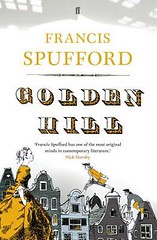 Golden Hill
Golden Hill
by Francis Spufford
![]()
I don’t throw stars around. When I give a book five of ’em, you can be assured I’m in love with it.
Francis Spufford’s brilliant first novel “Golden Hill” has everything: fascinating historical detail, adventures high and low, social commentary, romance (also high and low), double- and triple-dealing, fascinating twists, squalor, riches, even a duel. It excites from the first page to the last. My emotions ran the gamut while reading it, ending on a happy, satisfied plateau. What more can you ask of a novel?
1746, and a young man steps off the brig Henrietta in the city of New-York, freshly arrived from London. He makes a beeline for a counting-house, where he presents a note for a thousand pounds, refusing to state his business in the new world, thus becoming the most spoken- and whispered-about stranger in town.
The mysterious Richard Smith is closely observed, up close and from a distance, by everyone from the governor to the butcher to the slaves toiling in the homes of the wealthy. In the home of the merchant banker who now holds his note, he meets the Lovell family, striking up an almost immediate love-hate relationship with Tabitha Lovell. In a premonitory way, he notices (and is noticed by) the Lovell’s slave Zephyra.
The setting is pre-revolutionary New-York, a small city of just over 7,000 inhabitants, half Dutch, half British, both languages still in force though English is in its ascendency, with its Broad Way, its green common, its tall Amsterdam-style houses next to lower London-style structures. It is the New-York of Golden Hill, the Bouwerij, the British fort, Trinity church, and, a day’s ride away, Rutger’s Farm.
Taking breakfast at The Merchants, he is sought out by Septimus Oakeshott, secretary to the governor and master of the slave Achilles, characters who play increasingly-important roles as the story develops. The city and the characters come to life, contemporary and immediate. I felt I could step right into New-York with Richard Smith.
I love historical detail, especially when it is presented as fact, without unnecessary explanation. Here, for example, is Mr. Lovell, making change for Richard Smith, who needs spending money but does not yet understand the odd mixture of currencies and paper notes used in the colonies:
“A Mexica dollar, which we pass at eight-and-fourpence. A piece of four, half that. A couple of Portugee cruzeiros, three shillings New-York. A quarter-guilder. Two kreutzers, Lemberg. One kreutzer, Danish. Five sous. And a Moresco piece we can’t read, but it weighs at fourteen pennyweight, sterling, so we’ll call it two-and-six, New-York. Twenty-one and fourpence, total. Leaving a hundred and twenty-nine, tenpence-halfpenny to find in paper.”
Which is almost immediately stolen, setting in train a series of complications and blunders imperiling Richard Smith’s secret mission, a mission which remains secret until the final pages.
The secrecy is no cheap trick on Spufford’s part; it’s necessary and the reader will understand when the twist occurs, a twist that is at once revelatory and inspiring, the novel’s penultimate reward to the reader (the ultimate reward being the coda, written after the revolution by an older and wiser Tabitha).
God, this was a great read. I haven’t been this happy with a novel in years.
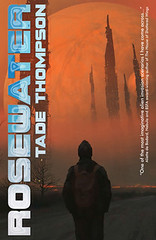 Rosewater
Rosewater
by Tade Thompson
![]()
A Goodreads friend said this about “Rosewater”:
“This book is one of those discoveries that not only is enjoyable for itself; it’s good enough to make me feel overall cheerily optimistic about the future of science fiction writing. Of course, this is not to be confused with ‘feeling cheery about the future;’ the effect here is quite the opposite, in fact.”
With an endorsement like that, I had to read it. It was everything she said, and more. As I read, I found myself as excited as I had been, decades ago, when I first read “The Fifth Head of Cerberus” by an up & comer named Gene Wolfe, or later, when I discovered the work of William Gibson.
“Rosewater” tells a hell of a story. Thompson says his science fiction stories are “about people, with incidental science,” but neither the people nor the science is incidental in “Rosewater.” Both are central to his complex first contact/alien invasion novel.
I particularly liked the main character Kaaro’s flashbacks to 2055 and his first encounters with the super-secret S45, the xenosphere, Femi, Wormwood, and Bicycle Girl. As other readers reported doing, I occasionally paged back to chapter heads to remind myself which timeline I was in, 2055 or 2066, but it was not bothersome: in fact, the very minor effort this entailed drew me even more into the story and enhanced my understanding of the world Thompson built.
Thompson is a master of introducing shocking plot elements through throwaway one-liners: when you run across one like “When America went dark,” your hair wants to stand on end. I suspect most Western readers will know enough of present-day Nigeria to be somewhat frightened of it; for sure I have heard of “necklacing,” and was perversely happy Thomas didn’t paint a prettier picture of the future Nigeria. Nigeria, along with the cast of characters who inhabit Lagos and Rosewater, is gritty and entirely believable.
There’s not a hint of the didactic in “Rosewater.” Thompson is a master of showing, of putting you in the story. “Rosewater” is brilliant, and I agree with my friend: the future of SF is assured.
 Word by Word: The Secret Life of Dictionaries
Word by Word: The Secret Life of Dictionaries
by Kory Stamper
![]()
Without naming the book, I posted a mid-read review of “Word by Word” to Facebook:
“I heard educated-sounding people on NPR pronounce ‘dour’ and ‘banal’ in ways that were new to me. It no doubt says something about me that I immediately assumed I’d been saying those words wrong all my life. That, in turn, made me feel insecure about other words I might be mispronouncing. Well, I’m reading a cool book about the making of dictionaries, and one of the chapters describes how lexicographers nail down pronunciations. I learned that online dictionary entries now include speaker icons you can click to hear how words are pronounced. It turns out I was saying dour and banal correctly and the snobs on NPR were saying them wrong. My self-confidence has been restored!”
As you might infer, I obsess over language and words. As a writer, I own several print dictionaries (including a giant library Unabridged Random House Dictionary that once sat, open, on a special stand by the card catalog cabinet), Strunk & White, Fowler’s, multiple copies of the AP Stylebook, and more. I have all the major online dictionaries and style guides bookmarked.
Kory Stamper, I feel a strong kinship with you. If Sarah Vowell and I could hang out with you (that is if Sarah Vowell would let me hang out with her in the first place), I’d be in heaven. Until we disagreed on some definition or point of style, that is. Just kidding.
This is a language enthusiast’s book, engagingly written and full of fascinating detail, not just about the words themselves, but about the process of revising and updating dictionaries, an amazingly rich and rigorous field … I literally had no idea how much work and research is involved.
Sadly, the book ends with an epilog about something I knew of but didn’t want to think about: layoffs and the decline of the dictionary publishing industry. Online references have decimated print sales, and the dream jobs of lexicographers and English lovers are fast disappearing.
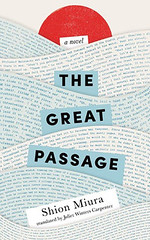 The Great Passage
The Great Passage
by Shion Miura
![]()
Clearly, I’ve been reading too many mysteries and thrillers, where every new object or action introduced into the story comes back later in some significant way. In real life … and Japanese novels … the second thing does not necessarily follow.
Just one example: at several points in the story, Nishioka brags about how easily he could move in on Kaguya, the woman loved by his seemingly timid co-worker Majime. He finds a love letter to Kaguya on Majime’s desk, reads it, and makes a copy. Aha, I thought, he’s going to do something awful with that copy.
Not so. Nishioka stays out of Majime’s way, and the copy doesn’t come into play until the epilogue, when Nishioka and Kishibe, the woman hired to replace Nishioka after he transferred to another department in the publishing house, read it together in a strangely affecting passage that moved me deeply.
Is it coincidence I read and loved a non-fiction book about the making of dictionaries, Kory Stamper’s “Word by Word: The Secret Life of Dictionaries,” just last month? As a word lover, I learned much from Stamper’s book. I have to say I learned at least as much about dictionaries from Miura’s novel (have you ever thought about the paper dictionaries are printed on?). Along the way I learned a great deal more about Japan and the Japanese, the language and the people.
Mostly, though, I was swept away by a beautifully-told story about people passionately dedicated to their professions and to one another. This is one of the most enjoyable novels I’ve read in a long time.
 The Handmaid’s Tale
The Handmaid’s Tale
Margaret Atwood
![]()
With the recent rightward shift in American government and the elevation of authoritarian Christians to positions of power in the president’s cabinet and personal staff, Margaret Atwood’s dystopian novel “The Handmaid’s Tale” is on many minds today. People are re-reading it; new readers are experiencing it for the first time; hundreds of thousands are watching Hulu’s TV adaptation. When Atwood makes public appearances, the first question she’s asked is “How close are we?”
Who can say? Atwood herself is reluctant to tackle that question. Still, “The Handmaid’s Tale” is convincing and believable. The society it describes doesn’t feel far-fetched. We know there are theocratic, woman-suppressing societies very much like it; we know there are some among us who would welcome it here.
As for the novel itself, it is highly readable. The unnamed narrator (her real name, that is, not her Handmaid name, which is Offred) is human and insightful. She can be caustic and occasionally funny. Along with clear-eyed descriptions of her present life in the commander’s household, she offers up memories of her former life: a college student, a free woman, later a wife and mother trying to stay under the radar as the theocrats take power and begin to clamp down. You want to infiltrate the alternate universe of the book and help her escape the clutches of Gilead.
How real was Winston Smith, in Orwell’s “1984”? How real were the characters in Huxley’s “Brave New World”? They were paper cutouts, there to populate hypothetical futures. Offred is real, contemporary, relatable. That the society she lives in is every bit as creepy and nightmarish as those of Orwell and Huxley is a bonus … Atwood can write a dystopian novel with the best of them, along with believable, relatable characters (as she demonstrates again in her recent MaddAddam trilogy).
My memory plays tricks. I thought I’d read “The Handmaid’s Tale” in college, but that was more than 15 years before it was published. Re-reading it now, I realize I’d finished only part of it before: the second half of the novel was new to me. Why did I read it again (or for the first time in full, take your pick)? For the same reasons as everyone else. It’s “truthy,” as Stephen Colbert would say; it offers a glimpse of what many on the religious right envision when they talk of making America great again. At the same time, it’s a novel of resistance: it inspires opposition to the forces that would restrict personal choice and freedom; essential reading for those who’ll fight to keep the hard-earned gains of recent decades.
And this: I read and review banned books for a periodic blog column titled “You Can’t Read That!” “The Handmaid’s Tale” has been challenged again and again, from its publication in 1985 to the present day, by those would ban it from public and school libraries, by those who do not want it taught to students in high school and even college. It consistently places on the American Library Association’s top 100 list of banned books, and with the renewed interest in the book (and now the Hulu TV adaptation) fresh challenges are popping up across the nation. If ever there was a timely choice for a review in my banned book column, “The Handmaid’s Tale” is it.
Challenges to “The Handmaid’s Tale” come primarily from parents who don’t want their children reading or discussing it in high school English classes. As with other controversial books on school reading lists, some parents simply want teachers to offer children alternative reading assignments; others want it taken off reading lists and removed from libraries so that no students can read it.
The ALA summarizes the most common objections cited in challenges to “The Handmaid’s Tale”: the inclusion of profane words; passages about sex; statements defamatory to minorities, god, women and the disabled; the book’s offensiveness to Christians; violence; hopelessness; moral corruption.
From the Parents Against Bad Books in Schools web site, here’s a description of one such challenge:
At a Fairfax County Public School Town Hall meeting on May 2, 2002 to discuss book selection a former FCPS teacher spoke about The Handmaid’s Tale. She spoke about the obscenities, masturbation, graphic violence, homosexuality, the use of drugs and alcohol, and abnormal sex in the book. She asked FCPS the following question: What are students in Fairfax County being inspired to do and to value by studying books like The Handmaid’s Tale?
From the ALA, here’s a description of another, more recent challenge:
The book was challenged for being “sexually explicit, violently graphic and morally corrupt,” according to the ALA’s annual roundup for Banned Books Week in 2013 and 2014, but was not ultimately removed from Page High School’s International Baccalaureate class. In Guilford, parents complained to members of the Board of Education that Atwood’s novel and Kurt Vonnegut’s Cat’s Cradle both “denigrate Christianity” and “tear down traditional values,” and circulated a petition to try to convince the district to change the curriculum.
I think the second challenge gets to the real issue, which is often unspoken. Parents who challenge the book, who want it banned, will count the number of dirty words and say it pushes a message of sex and violence; they’re less willing to admit to discomfort with the novel’s message. “The Handmaid’s Tale” describes a theocratic society in less than flattering terms, from the point of view of those it oppresses (women, in this case), with plenty of pokes at the hypocrisy of theocrats. The message is feminist, therefore liberal, therefore to be opposed. That is, I believe, what most of these challenges come down to, and is what they mean when they say the book is “offensive to Christians.”
Another Stephen Colbert quote comes to mind: “Reality has a well-known liberal bias.” People who challenge books that put their own conservative and religious fantasies to the test of real life fear the power of the written word. They fear novelists who, like Margaret Atwood, are articulate and insightful. They fear the power of “The Handmaid’s Tale.”
The challenges cited above, and others mentioned in the links below, were all overruled. “The Handmaid’s Tale” is still widely taught and studied across the USA and Canada. Still, only a fraction of challenges and attempts to ban the book are a matter of public record:
A recent survey by the National Coalition Against Censorship with the National Council of Teachers of English found that only seven percent of challenges get reported in the local press [and] three studies conducted in recent years—by the Oregon State Library, the Missouri School of Journalism and the Texas ACLU—… found that [only] three to 18 percent of challenges are reported.
We see only hints of the opposition to “The Handmaid’s Tale.” Offred saw only hints of what America was becoming … until she was swallowed up by Gilead. There won’t be any copies of this novel in the re-education camps, so you’d better read it now.
Links and references:
- Newsweek: Challenges and Bans Of “The Handmaid’s Tale” Aren’t Really Just about Sex or Profanity
- Washington Post: The Handmaid’s Tale Has Been Feared, Banned, and Loved. Now It’s Scaring the Bejeezus Out of Us Again.
- Comic Book Legal Defense Fund: The Handmaid’s Tale Under Attack in Oregon School
- Parents Against Bad Books In Schools:List of Challenged/Controversial Books by Title
- American Library Association: 100 Most Frequently Challenged Books by Decade
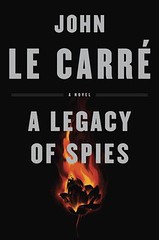 A Legacy of Spies
A Legacy of Spies
by John le Carré
![]()
From my review of an earlier le Carré novel, “A Delicate Truth”:
“Le Carré long ago moved on from the Cold War espionage era of his classic George Smiley character to the post-9/11, counter-terrorism, civilian contractor-dominated intelligence world of today, his later novels featuring mid-level actors in Britain’s foreign office and intelligence ministries. … You can feel le Carré’s anger with the direction covert intelligence-gathering has taken since the days when the Americans, led by Dick Cheney and his puppet George W. Bush, subverted and politicized the process, dragging Britain’s spy services down with them into a Keystone Kops frenzy of cherry-picking intelligence from favored sources, special rendition, torturing innocent and guilty suspects alike, and achieving nothing but failure after failure. Le Carré’s anger shines with a special intensity when he describes the yes-man atmosphere within Britain’s intelligence services today.”
I’ll say this, le Carré keeps us on our toes. His latest, “A Legacy of Spies,” returns to the Cold War era, populated (if in some cases at one or two removes) by his best-known characters, men like Peter Guillam and George Smiley. It expands on the tale originally told in le Carré’s most famous novel, “The Spy Who Came In from the Cold.”
I grew up in the Cold War; I served during the Cold War; I visited East Berlin multiple times during the Cold War. “The Spy Who Came In from the Cold” defined that era to readers of my generation. I don’t know about my fellow Baby Boomers, but I was terrified of it all; this is why I so admire the understated panache of le Carré’s spies as they fearlessly move about in Soviet-occupied territory, observing and being observed, playing targets and being played themselves, ever alert to the life-and-death stakes of the game they play. I love the attention le Carré lavishes on the Circus and its army of full- and part-time minders, technicians, and “housekeepers.” I hope such selfless servants of democracy exist in the real world, despite the depredations visited upon intelligence agencies during the Cheney-Bush-Blair era; le Carré almost convinces me they do.
“A Legacy of Spies” is entirely satisfying; the spymaster has lost none of his power.
 The Rise and Fall of D.O.D.O.
The Rise and Fall of D.O.D.O.
by Neal Stephenson & Nicole Galland
![]()
A collaboration, and I’m hard-pressed to guess which author wrote which parts, though I note that overall the novel has the feel (and heft) of a solo Stephenson epic.
The difference with this epic is the combination of the supernatural (witchcraft and magic) with near-future science fiction (the cryogenically-cooled isolation chambers that allow magic to be performed in a non-magical world).
Fantasy and the supernatural have little appeal for me, but the matter-of-fact way Stephenson and Galland mix magic with science, along with believable contemporary characters, the inevitable bureaucracy growing around what started out as a shoestring operation to explore the possibilities of magic in the modern world, and a cast of witches and anachrons brought forward from past eras, make it palatable. In fact, this is a most enjoyable read, and despite the novel’s 700+ page length, I breezed right through it.
It’s written in epistolary style, consisting of journal entries; in-house D.O.D.O. message traffic, taped conversations, and directives copied from the organization’s server; letters sent to a spymaster by an Elizabethan-era Irish witch; diary entries written by a scientist’s wife (who turns out to be a witch herself); and a fascinating Viking epic titled the Lay of Walmart.
Also, too, I liked Stepenson and Gallande’s take on messing with the past: with great persistence you can change small things, but if you seriously threaten the future, you’d better be ready to run.
“The Rise and Fall of D.O.D.O.” is a blast to read, at once playful, funny, and suspenseful … an ambitious task for any author, but Stephenson and Galland pull it off.
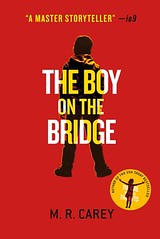 The Boy on the Bridge (The Girl With All The Gifts #2)
The Boy on the Bridge (The Girl With All The Gifts #2)
by M.R. Carey
![]()
From my earlier review of “The Girl with All the Gifts“:
“The only time I was tempted to say “Oh, come on!” was when the intrepid band of humans (and one zombie) find the safe haven of an unmolested armored research vehicle in the heart of an abandoned and looted London, but I forgave the author that small deus ex machina.”
The vehicle is back. The Rosalind Franklin is sent out from the besieged human enclave of Beacon on a research mission through England and Scotland, manned by military personnel and a scientific team. The scientists’ mission is to collect tissue samples from Hungries, tissue that may help humans find a cure or at least a vaccine to prevent infection. The story centers around one member of the scientific team, the autistic teenaged boy of the title, who makes an amazing discovery.
“The Boy on the Bridge” is set in the world of “The Girl with All the Gifts,” a world devastated by a fast-acting fungal disease that turns humans into “hungries,” zombie-like creatures that exist only to eat flesh, human or animal. Think of the British zombie movies “28 Days Later” and “28 Weeks Later” (I actually checked to see if M.R. Carey had a hand in writing those screenplays–to my surprise he didn’t, although he did work on the movie adaptation of “The Girl with All the Gifts”).
The story laid out in this novel takes place prior to the story of “The Girl with All the Gifts,” but the two novels tie together, and the Girl herself makes an appearance at the end of Boy. That’s not meant to be a spoiler–it’s meant to entice you to read this one if you loved the first one as much as I did.
M.R. Carey is a gifted storyteller. As with Girl, I was completely taken in by the plot and characters, on the edge of my seat from the first page to the last.
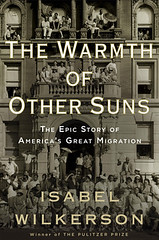 The Warmth of Other Suns: The Epic Story of America’s Great Migration
The Warmth of Other Suns: The Epic Story of America’s Great Migration
by Isabel Wilkerson
![]()
“The Warmth of Other Suns” examines the lives of three southern black Americans who moved north and west during the period of the Great Migration. The two men and one woman Isabel Wilkerson focuses on are good representatives of the 6 million who made up the whole: one follows the seacoast from Florida to New York City; one follows the well-worn path from Alabama and Mississippi to midwestern cities like Chicago and Detroit; one heads west to California, as so many from Louisiana and Texas did. The stories of these three people, along with the stories of their wives, husbands, and children, are told in separate and short biographical chapters.
Isabel Wilkerson’s book also recounts the overall history of the Great Migration. She fills in the gaps between biographical chapters with broad-brushed chapters about the South the migrants came from; vivid and chilling examples of the increasingly draconian Jim Crow laws southern blacks had to navigate in every aspect of their daily lives; the routes and patterns followed by black migrants from different parts of the former Confederacy; the nature and types of discrimination they faced in the North. I knew about the North and the historical patterns of segregation there; I had no appreciation of the scope and extent of the Jim Crow laws in the South. These chapters in particular opened my eyes and will stay with me for a long time.
I will note, as I see other reviewers have before me, that absolutely none of this was taught in school to anyone in my generation. I am willing to bet it isn’t taught now. There is thus great value in this book and others that examine the experience of black American citizens and their struggle. I salute Isabel Wilkerson. She made an impact on me.
“The Warmth of Other Suns” feels like one of those books challenged by parents and sometimes yanked from school libraries and reading lists by timid administrators looking to avoid confrontation. I searched for information on challenges and bans and found nothing. Perhaps, as I speculated above, this book is infrequently taught in middle and high school, if it is taught at all. That would be a shame.
Now for my only quibble:
There’s a pattern to most of the 30-minute automotive shows on cable TV. Each consists of four or five short segments, broken by commercials. During each segment, we see a preview of what’s to come in the next segment. When each new segment starts, we see flashbacks to the previous segment. Thus, minus commercials, 22 minutes of car show contains roughly 12 minutes of content.
There are no commercials in “The Warmth of Other Suns,” of course, but each biographical chapter previews the next, while each new chapter repeats details we already digested while reading earlier chapters. This is the repetitiveness so many reviewers complain of. It is unnecessary and I wish Isabel Wilkerson had cut out the previews and flashbacks … her great work would have been tighter and more impactful without constant repetition.
 Persuader (Jack Reacher #7) |
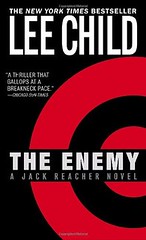 The Enemy (Jack Reacher #8) |
 One Shot (Jack Reacher #9) |
The last review is for a series of escapist thrillers, Lee Child’s Jack Reacher novels, which I’m reading in order. I started last year with the first one, “Killing Floor,” and, if I outlive the author, may some day get to the last one (right now that is #22, “The Midnight Line”). This is a combined review of three I read this year, the seventh through the ninth novels, “Persuader,” “The Enemy” and “One Shot.” Of these, I rated “The Enemy” at four stars, my highest rating to date for a Jack Reacher novel. —Paul
A couple of the first six Reacher novels are terrible. The rest are good to very good. The thing is, Jack Reacher in his natural state is a great character: he’s strong, skilled, smart, taciturn to a fault. By choice he has no job and no fixed address, but wherever he goes he winds up investigating a crime, either on his own volition or at the behest of strangers. He’s a keen observer. He figures things out. He gets into horrible scrapes, often (always?) winding up in jail himself, accused of committing the very crimes he’s investigating. He beds a succession of smart women characters who help him solve crimes. He beats up the bad guys. He’s the world’s deadliest sniper. And so on.
And yet in every novel Reacher breaks character to become another kind of detective, not the man of action but a tough-guy version of Hercule Poirot, subjecting possible culprits and baffled policemen or FBI agents to lengthy monologues where he explains what when down, how he figured it out, and naming the guilty. The culprit, dead to rights, makes a move, the lights go out, gunfire ensues, yadda yadda.
Which is to say Jack Reacher is a unique & memorable character trapped in a series of conventional & not so memorable mystery plots. Sometimes Child handles this well and you don’t notice so much. Other times he handles it poorly, and you want to throw the book across the room.
“Persuader,” Jack Reacher #7, is tightly-plotted and tense. Reacher is fully in character. So are the bad guys. So are the alluring women from Reacher’s past & present … surprisingly, he doesn’t bed the current woman until halfway through the novel. A subplot involving an investigation from Reacher’s military days is very well done, as are the descriptions of weapons favored by gangsters and terrorists. The fight scenes are as good as any I’ve read. I noticed that this novel is narrated in the first person. I think most of the earlier ones used the third-person voice. I liked this one better, and will be watching Child’s narrative technique more closely from now on.
“The Enemy,” Jack Reacher #8, is my favorite Reacher novel to date and earned four stars. I think I liked it as much as I did because it echoed aspects of my own military career, set as it is during Reacher’s time as a military police officer, working high level criminal activity inside the Army. The earlier novels are set at later dates, after Reacher left the Army and became a rootless solver of crimes and friend of the oppressed. I hope some of the later novels return to Reacher’s Army days. What I know of the Army (I was Air Force myself) seems well-researched, another reason to like the book.
“One Shot,” Jack Reacher #9, jumps ahead to Reacher’s post-Army days (as do the first seven novels), but some of the opposing characters in this one were known to him when he was in uniform, and his experience as an MP goes a long way toward helping him solve the case he’s investigating. There are a lot of 180-degree turns in this novel, so many that it became a bit of a distraction in later chapters. I came to believe that Lee Child was lurking over my shoulder, just waiting for me to think, “Oh, I get it,” before springing another loop on me. Child’s trickiness came across as gratuitous, and I rated this novel a little lower than the previous one.
All three novels are good reads for Jack Reacher fans, and I guess by this point I’ve become one. As with James Bond, Jack Reacher is escapist bullshit, but what great fun this escapist bullshit is!